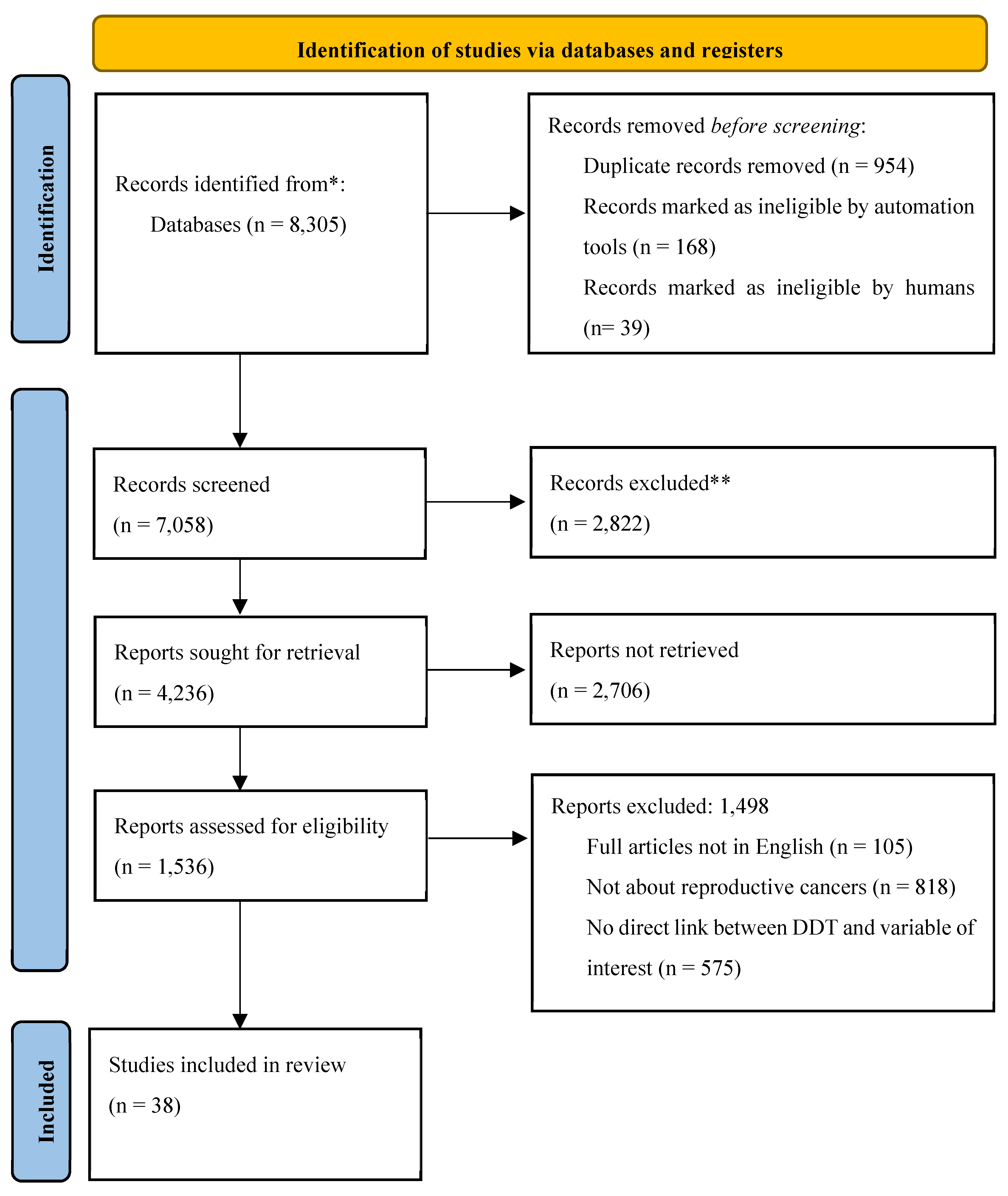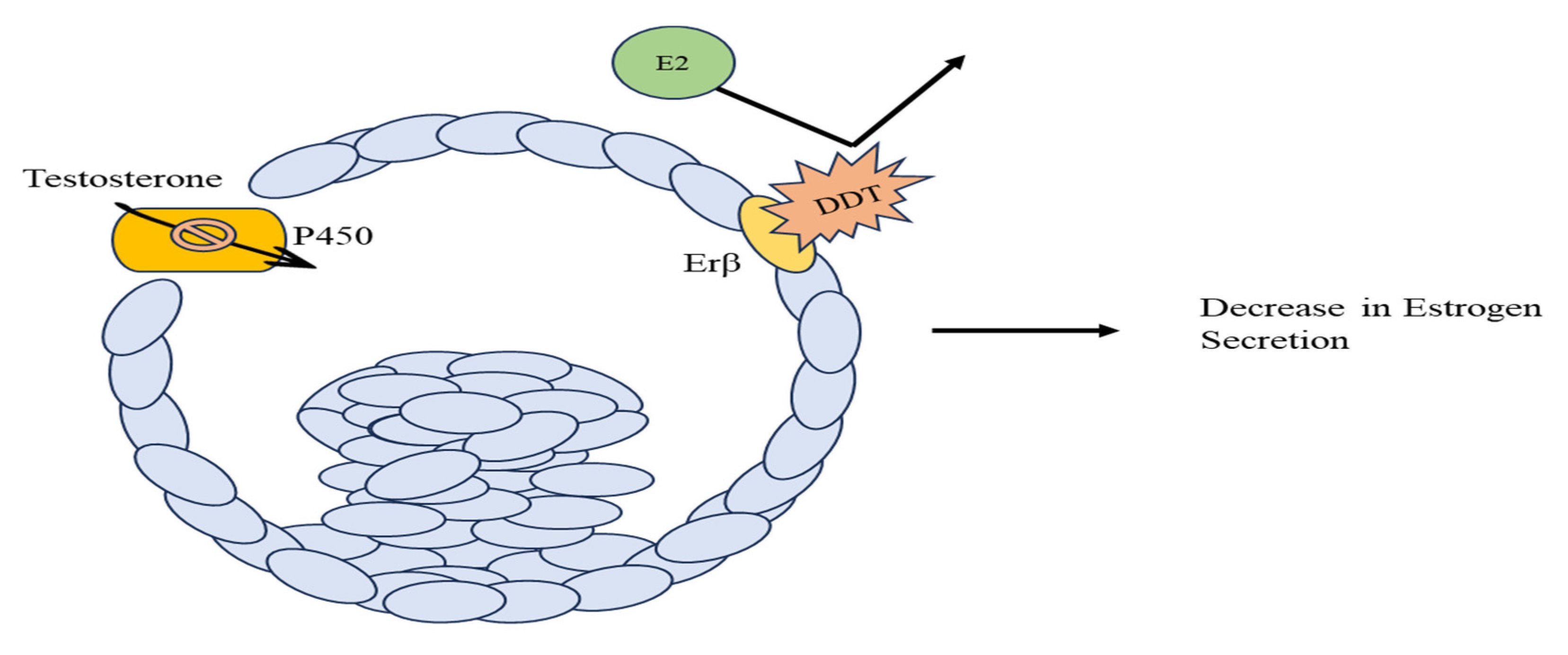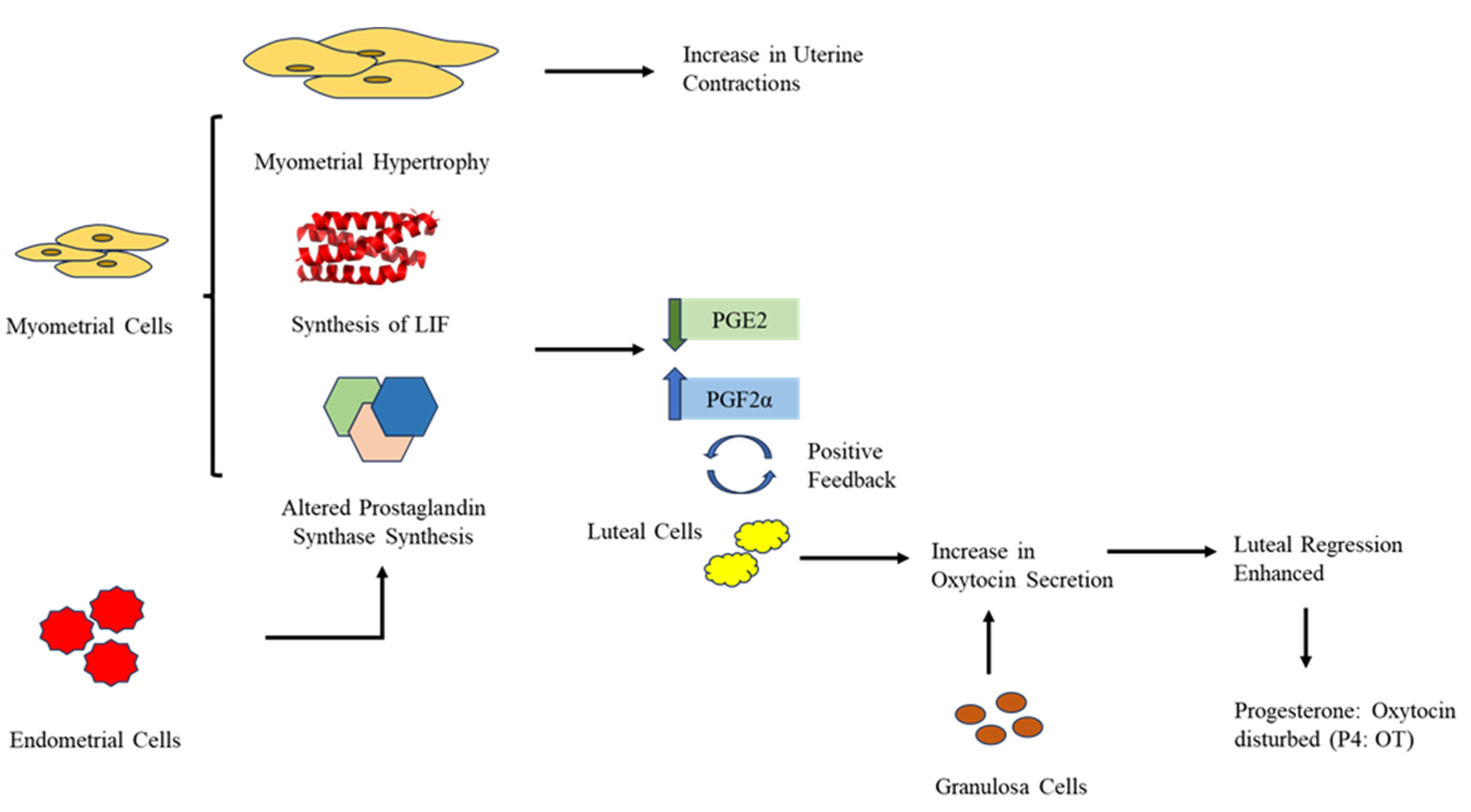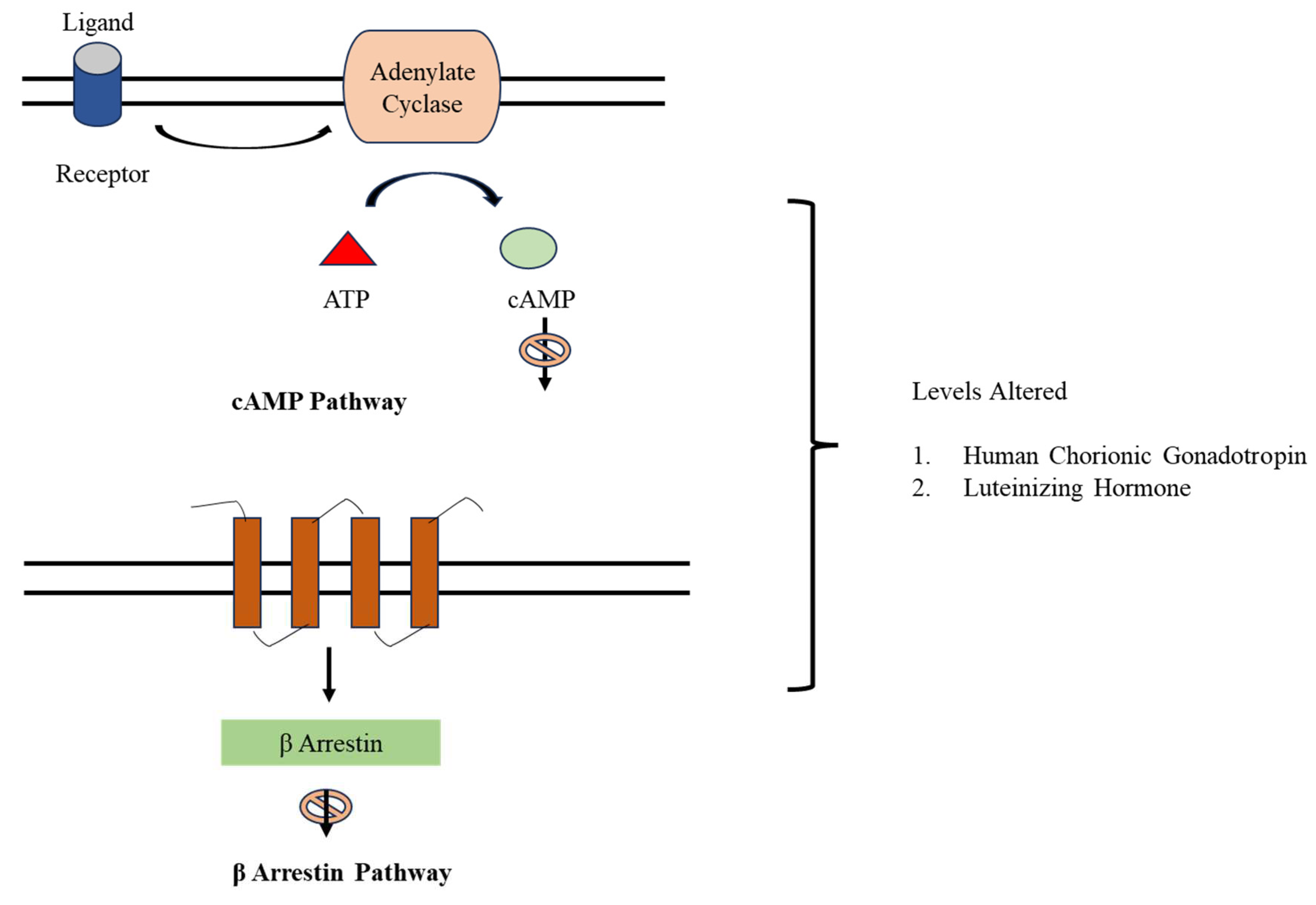Submitted:
25 July 2023
Posted:
27 July 2023
You are already at the latest version
Abstract
Keywords:
1. Introduction
2. Methodology
3. Results and Discussion
3.1. Role of DDT in female infertility
3.1.1. In-vitro studies
3.1.2. Epidemiological studies
3.2. Role of DDT in female reproductive cancers
4. Conclusion
Author Contributions
Conflicts of Interest
Abbreviations
| AR | Androgen Receptor |
| cAMP | Cyclic Adenosine 3΄, 5΄-monophosphate |
| CP | Clinical Pregnancy |
| Cx | Connexin |
| DDD | Dichlorodiphenyldichloroethane |
| DDE | Dichlorodiphenyldichloroethylene |
| DDT | Dichlorodiphenyltrichloroethane |
| E2 | Estradiol |
| EDC | Endocrine-disrupting Chemicals |
| EPL | Early Pregnancy Loss |
| ER | Estrogen Receptor |
| Erβ | Estrogen Receptor Beta |
| FSH | Follicle Stimulating Hormone |
| hCG | Human Chorionic Gonadotropin |
| hCG/LHR | Human Chorionic Gonadotropin/Luteinizing Hormone Receptor |
| LEH | Luminal Epithelial Height |
| LH | Luteinizing Hormone |
| LIF | Leukemia Inhibitor Factor |
| NP-I | Neurophysin-1 |
| ο,p΄-DDD | ortho, para΄-Dichlorodiphenyldichloroethane |
| ο,p΄-DDE | ortho, para΄-Dichlorodiphenyldichloroethylene |
| ο,p΄-DDT | ortho, para΄-Dichlorodiphenyltrichloroethane |
| OCP | Organochlorine Pesticide |
| OCP | Organochlorine Pesticide |
| OT | Oxytocin |
| p,p΄-DDE | para, para΄-Dichlorodiphenyldichloroethylene |
| p,p΄- DDT | para, para΄-Dichlorodiphenyltrichloroethane |
| p,p΄-DDD | para, para΄-Dichlorodiphenyldichloroethane |
| P4 | Progesterone |
| PGA | Prostaglandin A |
| PGE2 | Prostaglandin E2 |
| PGF2α | Prostaglandin F2 alpha |
| LOG | Length of gestation |
| POP | Persistent Organic Pollutant |
| PRISMA | Preferred Reporting Items for Systematic Reviews and Meta-Analysis |
| PTB | Preterm Birth |
| ROS | Reactive Oxygen Species |
| SGA | Small for Gestational Age |
| TTP | Time to Pregnancy |
| UWW | Uterine Wet Weight |
References
- Burgos-Aceves, M.A.; Migliaccio, V.; Di Gregorio, I.; Paolella, G.; Lepretti, M.; Faggio, C.; Lionetti, L.J.E.T.; Pharmacology. 1, 1, 1-trichloro-2, 2-bis (p-chlorophenyl)-ethane (DDT) and 1, 1-Dichloro-2, 2-bis (p, p’-chlorophenyl) ethylene (DDE) as endocrine disruptors in human and wildlife: A possible implication of mitochondria. Environmental Toxicology and Pharmacology 2021, 87, 103684. [Google Scholar] [CrossRef]
- Nadal, M.; Marquès, M.; Mari, M.; Domingo, J.L. Climate change and environmental concentrations of POPs: A review. Environ. Res. 2015, 143, 177–185. [Google Scholar] [CrossRef] [PubMed]
- Hernández-Mariano, J. .; Baltazar-Reyes, M.C.; Salazar-Martínez, E.; Cupul-Uicab, L.A. Exposure to the pesticide DDT and risk of diabetes and hypertension: Systematic review and meta-analysis of prospective studies. Int. J. Hyg. Environ. Heal. 2021, 239, 113865. [Google Scholar] [CrossRef] [PubMed]
- Russo, F.; Ceci, A.; Pinzari, F.; Siciliano, A.; Guida, M.; Malusà, E.; Tartanus, M.; Miszczak, A.; Maggi, O.; Persiani, A.M. Bioremediation of Dichlorodiphenyltrichloroethane (DDT)-Contaminated Agricultural Soils: Potential of Two Autochthonous Saprotrophic Fungal Strains. Appl. Environ. Microbiol. 2019, 85. [Google Scholar] [CrossRef]
- Binelli, A.; Provini, A. DDT is still a problem in developed countries: the heavy pollution of Lake Maggiore. Chemosphere 2003, 52, 717–723. [Google Scholar] [CrossRef]
- Bouwman, H.; Kylin, H.; Sereda, B.; Bornman, R. High levels of DDT in breast milk: Intake, risk, lactation duration, and involvement of gender. Environ. Pollut. 2012, 170, 63–70. [Google Scholar] [CrossRef] [PubMed]
- Nicolella, H.D.; de Assis, S.J.I.J.o.M.S. Epigenetic inheritance: Intergenerational effects of pesticides and other endocrine disruptors on cancer development. International Journal of Molecular Sciences 2022, 23, 4671. [Google Scholar] [CrossRef]
- Fucic, A.; Duca, R.C.; Galea, K.S.; Maric, T.; Garcia, K.; Bloom, M.S.; Andersen, H.R.; Vena, J.E. Reproductive Health Risks Associated with Occupational and Environmental Exposure to Pesticides. Int. J. Environ. Res. Public Heal. 2021, 18, 6576. [Google Scholar] [CrossRef]
- Qi, S.-Y.; Xu, X.-L.; Ma, W.-Z.; Deng, S.-L.; Lian, Z.-X.; Yu, K. Effects of Organochlorine Pesticide Residues in Maternal Body on Infants. Front. Endocrinol. 2022, 13, 890307. [Google Scholar] [CrossRef]
- Sifakis, S.; Androutsopoulos, V.P.; Tsatsakis, A.M.; Spandidos, D.A. Human exposure to endocrine disrupting chemicals: effects on the male and female reproductive systems. Environ. Toxicol. Pharmacol. 2017, 51, 56–70. [Google Scholar] [CrossRef]
- E Nilsson, E.; Ben Maamar, M.; Skinner, M.K. Role of epigenetic transgenerational inheritance in generational toxicology. Environ. Epigenetics 2022, 8, dvac001. [Google Scholar] [CrossRef]
- Petrakis, D.; Vassilopoulou, L.; Mamoulakis, C.; Psycharakis, C.; Anifantaki, A.; Sifakis, S.; Docea, A.O.; Tsiaoussis, J.; Makrigiannakis, A.; Tsatsakis, A.M. Endocrine Disruptors Leading to Obesity and Related Diseases. Int. J. Environ. Res. Public Heal. 2017, 14, 1282. [Google Scholar] [CrossRef]
- Brehm, E.; Flaws, J.A.J.E. Transgenerational effects of endocrine-disrupting chemicals on male and female reproduction. Endocrinology 2019, 160, 1421–1435. [Google Scholar] [CrossRef] [PubMed]
- de Solla, S.R.; King, L.E.; Gilroy. A. Environmental exposure to non-steroidal anti-inflammatory drugs and potential contribution to eggshell thinning in birds. Environ. Int. 2023, 171, 107638. [Google Scholar] [CrossRef]
- de Jager, C.; Patrick, S.; Aneck-Hahn, N.; Bornman, M. Environmental Toxicants and Sperm Production in Men and Animals. Proceedings of XIIIth International Symposium on Spermatology; pp. 47–59.
- Amir, S.; Shah, S.T.A.; Mamoulakis, C.; Docea, A.O.; Kalantzi, O.-I.; Zachariou, A.; Calina, D.; Carvalho, F.; Sofikitis, N.; Makrigiannakis, A.; et al. Endocrine Disruptors Acting on Estrogen and Androgen Pathways Cause Reproductive Disorders through Multiple Mechanisms: A Review. Int. J. Environ. Res. Public Heal. 2021, 18, 1464. [Google Scholar] [CrossRef]
- Interdonato, L.; Siracusa, R.; Fusco, R.; Cuzzocrea, S.; Di Paola, R. Endocrine Disruptor Compounds in Environment: Focus on Women’s Reproductive Health and Endometriosis. Int. J. Mol. Sci. 2023, 24, 5682. [Google Scholar] [CrossRef] [PubMed]
- Mrema, E.J.; Rubino, F.M.; Brambilla, G.; Moretto, A.; Tsatsakis, A.M.; Colosio, C. Persistent organochlorinated pesticides and mechanisms of their toxicity. Toxicology 2012, 307, 74–88. [Google Scholar] [CrossRef] [PubMed]
- Page, M.J.; McKenzie, J.E.; Bossuyt, P.M.; Boutron, I.; Hoffmann, T.C.; Mulrow, C.D.; Shamseer, L.; Tetzlaff, J.M.; Akl, E.A.; Brennan, S.E.; et al. The PRISMA 2020 statement: An updated guideline for reporting systematic reviews. Int. J. Surg. 2021, 88, 105906. [Google Scholar] [CrossRef] [PubMed]
- Wójtowicz, A.K.; Gregoraszczuk, E.L.; Ptak, A.; Falandysz, J. Effect of single and repeated in vitro exposure of ovarian follicles to o,p'-DDT and p,p'-DDT and their metabolites. Pol. J. Pharmacol. 2004, 56. [Google Scholar]
- Wrobel, M.; Mlynarczuk, J.; Kotwica, J. The adverse effect of dichlorodiphenyltrichloroethane (DDT) and its metabolite (DDE) on the secretion of prostaglandins and oxytocin in bovine cultured ovarian and endometrial cells. Reprod. Toxicol. 2009, 27, 72–78. [Google Scholar] [CrossRef] [PubMed]
- Mlynarczuk, J.; Górska, M.; Wrobel, M. Effects of DDT, DDE, aldrin and dieldrin on prostaglandin, oxytocin and steroid hormone release from smooth chorion explants of cattle. Anim. Reprod. Sci. 2020, 223, 106623. [Google Scholar] [CrossRef] [PubMed]
- Wojciechowska, A.; Młynarczuk, J.; Kotwica, J.J.P.J.o.V.S. The protein expression disorders of connexins (Cx26, Cx32 and Cx43) and keratin 8 in bovine placenta under the influence of DDT, DDE and PCBs. Polish Journal of Veterinary Sciences 2018, 21, 721–729. [Google Scholar]
- Mlynarczuk, J.; Wrobel, M.H.; Kotwica, J. Effect of environmental pollutants on oxytocin synthesis and secretion from corpus luteum and on contractions of uterus from pregnant cows. Toxicol. Appl. Pharmacol. 2010, 247, 243–249. [Google Scholar] [CrossRef] [PubMed]
- Wojciechowska, A.; Mlynarczuk, J.; Kotwica, J. Changes in the mRNA expression of structural proteins, hormone synthesis and secretion from bovine placentome sections after DDT and DDE treatment. Toxicology 2017, 375, 1–9. [Google Scholar] [CrossRef] [PubMed]
- Wrobel, M.H.; Bedziechowski, P.; Mlynarczuk, J.; Kotwica, J. Impairment of uterine smooth muscle contractions and prostaglandin secretion from cattle myometrium and corpus luteum in vitro is influenced by DDT, DDE and HCH. Environ. Res. 2014, 132, 54–61. [Google Scholar] [CrossRef]
- Wójtowicz, A.K.; Kajta, M.; Gregoraszczuk, E. . DDT- and DDE-induced disruption of ovarian steroidogenesis in prepubertal porcine ovarian follicles: a possible interaction with the main steroidogenic enzymes and estrogen receptor beta. J. Physiol. Pharmacol. : Off. J. Pol. Physiol. Soc. 2007, 58. [Google Scholar]
- Munier, M.; Ayoub, M.; Suteau, V.; Gourdin, L.; Henrion, D.; Reiter, E.; Rodien, P.J.A.o.T. In vitro effects of the endocrine disruptor p, p′ DDT on human choriogonadotropin/luteinizing hormone receptor signalling. Archives of Toxicology 2021, 95, 1671–1681. [Google Scholar] [CrossRef]
- Kwekel, J.C.; Forgacs, A.L.; Williams, K.J.; Zacharewski, T.R.J.T.; pharmacology, a. op′-DDT-mediated uterotrophy and gene expression in immature C57BL/6 mice and Sprague–Dawley rats. Toxicology and applied pharmacology 2013, 273, 532–541. [Google Scholar] [CrossRef] [PubMed]
- Salleh, N.; Giribabu, N.; Feng, A.O.M.; Myint, K.J.I.j.o.m.s. Bisphenol A, dichlorodiphenyltrichloroethane (DDT) and vinclozolin affect ex-vivo uterine contraction in rats via uterotonin (prostaglandin F2α, acetylcholine and oxytocin) related pathways. International journal of medical sciences 2015, 12, 914. [Google Scholar] [CrossRef]
- Lyche, J.L.; Nourizadeh-Lillabadi, R.; Almaas, C.; Stavik, B.; Berg, V.; Skåre, J.U.; Alestrøm, P.; Ropstad, E. Natural Mixtures of Persistent Organic Pollutants (POP) Increase Weight Gain, Advance Puberty, and Induce Changes in Gene Expression Associated with Steroid Hormones and Obesity in Female Zebrafish. J. Toxicol. Environ. Heal. Part A 2010, 73, 1032–1057. [Google Scholar] [CrossRef]
- Anand, M.; Agarwal, P.; Singh, L.; Taneja, A. Persistent organochlorine pesticides and oxidant/antioxidant status in the placental tissue of the women with full-term and pre-term deliveries. Toxicol. Res. 2015, 4, 326–332. [Google Scholar] [CrossRef]
- Anand, M.; Singh, L.; Agarwal, P.; Saroj, R.; Taneja, A. Pesticides exposure through environment and risk of pre-term birth: a study from Agra city. Drug Chem. Toxicol. 2017, 42, 471–477. [Google Scholar] [CrossRef]
- A Cohn, B.; Cirillo, P.M.; Wolff, M.S.; Schwingl, P.J.; Cohen, R.D.; I Sholtz, R.; Ferrara, A.; E Christianson, R.; Berg, B.J.v.D.; Siiteri, P.K. DDT and DDE exposure in mothers and time to pregnancy in daughters. Lancet 2003, 361, 2205–2206. [Google Scholar] [CrossRef]
- Mahalingaiah, S.; Missmer, S.A.; Maity, A.; Williams, P.L.; Meeker, J.D.; Berry, K.; Ehrlich, S.; Perry, M.J.; Cramer, D.W.; Hauser, R.J.E.h.p. Association of hexachlorobenzene (HCB), dichlorodiphenyltrichloroethane (DDT), and dichlorodiphenyldichloroethylene (DDE) with in vitro fertilization (IVF) outcomes. Environmental health perspectives 2012, 120, 316–320. [Google Scholar] [CrossRef] [PubMed]
- Torres-Arreola, L.; Berkowitz, G.; Torres-Sánchez, L.; López-Cervantes, M.; E Cebrián, M.; Uribe, M.; López-Carrillo, L. Preterm Birth in Relation to Maternal Organochlorine Serum Levels. Ann. Epidemiology 2003, 13, 158–162. [Google Scholar] [CrossRef]
- Tyagi, V.; Garg, N.; Mustafa, M.D.; Banerjee, B.D.; Guleria, K. Organochlorine pesticide levels in maternal blood and placental tissue with reference to preterm birth: a recent trend in North Indian population. Environ. Monit. Assess. 2015, 187, 471. [Google Scholar] [CrossRef]
- Arrebola, J.P.; Cuellar, M.; Bonde, J.P.; González-Alzaga, B.; Mercado, L.A.J.E.R. Associations of maternal o, p′-DDT and p, p′-DDE levels with birth outcomes in a Bolivian cohort. Environmental Research 2016, 151, 469–477. [Google Scholar] [CrossRef]
- Farhang, L.; Weintraub, J.M.; Petreas, M.; Eskenazi, B.; Bhatia, R. Association of DDT and DDE with Birth Weight and Length of Gestation in the Child Health and Development Studies, 1959–1967. Am. J. Epidemiology 2005, 162, 717–725. [Google Scholar] [CrossRef] [PubMed]
- Kezios, K.L.; Liu, X.; Cirillo, P.M.; Cohn, B.A.; Kalantzi, O.I.; Wang, Y.; Petreas, M.X.; Park, J.-S.; Factor-Litvak, P. Dichlorodiphenyltrichloroethane (DDT), DDT metabolites and pregnancy outcomes. Reprod. Toxicol. 2012, 35, 156–164. [Google Scholar] [CrossRef]
- Longnecker, M.P.; Klebanoff, M.A.; Dunson, D.B.; Guo, X.; Chen, Z.; Zhou, H.; Brock, J.W. Maternal serum level of the DDT metabolite DDE in relation to fetal loss in previous pregnancies. Environ. Res. 2005, 97, 127–133. [Google Scholar] [CrossRef]
- Ouyang, F.; Longnecker, M.P.; Venners, S.A.; Johnson, S.; Korrick, S.; Zhang, J.; Xu, X.; Christian, P.; Wang, M.-C.; Wang, X.J.T.A.J.o.C.N. Preconception serum 1, 1, 1-trichloro-2, 2, bis (p-chlorophenyl) ethane and B-vitamin status: independent and joint effects on women’s reproductive outcomes. The American Journal of Clinical Nutrition 2014, 100, 1470–1478. [Google Scholar] [CrossRef] [PubMed]
- Perry, M.J.; Ouyang, F.; Korrick, S.A.; Venners, S.A.; Chen, C.; Xu, X.; Lasley, B.L.; Wang, X. A Prospective Study of Serum DDT and Progesterone and Estrogen Levels across the Menstrual Cycle in Nulliparous Women of Reproductive Age. Am. J. Epidemiology 2006, 164, 1056–1064. [Google Scholar] [CrossRef] [PubMed]
- Venners, S.A.; Korrick, S.; Xu, X.; Chen, C.; Guang, W.; Huang, A.; Altshul, L.; Perry, M.; Fu, L.; Wang, X. Preconception Serum DDT and Pregnancy Loss: A Prospective Study Using a Biomarker of Pregnancy. Am. J. Epidemiology 2005, 162, 709–716. [Google Scholar] [CrossRef]
- Harley, K.G.; Marks, A.R.; Bradman, A.; Barr, D.B.; Eskenazi, B.J.J.o.o.; Occupational, e.m.A.C.o.; Medicine, E. DDT exposure, work in agriculture, and time to pregnancy among farmworkers in California. Journal of occupational and environmental medicine/American College of Occupational and Environmental Medicine 2008, 50, 1335. [Google Scholar] [CrossRef]
- Ouyang, F.; Perry, M.J.; A Venners, S.; Chen, C.; Wang, B.; Yang, F.; Fang, Z.; Zang, T.; Wang, L.; Xu, X.; et al. Serum DDT, age at menarche, and abnormal menstrual cycle length. Occup. Environ. Med. 2005, 62, 878–884. [Google Scholar] [CrossRef] [PubMed]
- Chen, A.; Zhang, J.; Zhou, L.; Gao, E.-S.; Chen, L.; Rogan, W.J.; Wolff, M.S. DDT serum concentration and menstruation among young Chinese women. Environ. Res. 2005, 99, 397–402. [Google Scholar] [CrossRef]
- Weiss, J.M.; Bauer, O.; Blüthgen, A.; Ludwig, A.K.; Vollersen, E.; Kaisi, M.; Al-Hasani, S.; Diedrich, K.; Ludwig, M. Distribution of persistent organochlorine contaminants in infertile patients from Tanzania and Germany. J. Assist. Reprod. Genet. 2006, 23, 393–399. [Google Scholar] [CrossRef]
- Windham, G.C.; Lee, D.; Mitchell, P.; Anderson, M.; Petreas, M.; Lasley, B. Exposure to Organochlorine Compounds and Effects on Ovarian Function. Epidemiology 2005, 16, 182–190. [Google Scholar] [CrossRef]
- Bredhult, C.; Bäcklin, B.-M.; Bignert, A.; Olovsson, M. Study of the relation between the incidence of uterine leiomyomas and the concentrations of PCB and DDT in Baltic gray seals. Reprod. Toxicol. 2008, 25, 247–255. [Google Scholar] [CrossRef]
- A Gibson, D.; Saunders, P.T.K. Endocrine disruption of oestrogen action and female reproductive tract cancers. Endocrine-Related Cancer 2013, 21, T13–T31. [Google Scholar] [CrossRef]
- Kalinina, T.S.; Kononchuk, V.V.; Ovchinnikov, V.Y.; Chanyshev, M.D.; Gulyaeva, L.F. Expression of the miR-190 family is increased under DDT exposure in vivo and in vitro. Mol. Biol. Rep. 2018, 45, 1937–1945. [Google Scholar] [CrossRef]
- Mathur, V.; John, P.J.; Soni, I.; Bhatnagar, P. Bhatnagar, P. Blood Levels of Organochlorine Pesticide Residues and Risk of Reproductive Tract Cancer Among Women from Jaipur, India. 2008, 617, 387–394. 617. [CrossRef]
- Ndebele, K.; Graham, B.; Tchounwou, P.B.J.I.J.o.E.R.; Health, P. Estrogenic activity of coumestrol, DDT, and TCDD in human cervical cancer cells. International Journal of Environmental Research and Public Health 2010, 7, 2045–2056. [Google Scholar] [CrossRef] [PubMed]
- Radhakrishnan, G.; Priyadarshini, V.; Singh, A. Association of Serum and Cervical Tissue Levels of Organochlorine Pesticides with Cervical Cancer in Women of East Delhi: A Case Control Pilot Study. J. South Asian Fed. Obstet. Gynaecol. 2019, 11, 190–193. [Google Scholar] [CrossRef]
- Rodríguez. G.P.; López, M.I.R.; Casillas, T..D.; León, J.A.A.; Mahjoub, O.; Prusty, A.K. Monitoring of organochlorine pesticides in blood of women with uterine cervix cancer. Environ. Pollut. 2017, 220, 853–862. [Google Scholar] [CrossRef] [PubMed]
- Sharma, T.; Banerjee, B.D.; Mazumdar, D.; Tyagi, V.; Thakur, G.; Guleria, K.; Ahmed, R.S.; Tripathi, A.K. Association of organochlorine pesticides and risk of epithelial ovarian cancer: A case control study. J. Reprod. Heal. Med. 2015, 1, 76–82. [Google Scholar] [CrossRef]






| Chemical/Hormone | DDT Isomer | Levels of Chemical/Hormone |
| Estradiol | ο,p΄-DDT | Increase or Decrease |
| ο,p΄-DDE | Increase or Decrease | |
| ο,p΄-DDD | Increase or Decrease | |
| p,p΄-DDT | Increase | |
| p ,p΄-DDE | Increase | |
| Oxytocin | DDT | Increase |
| DDE | Increase | |
| Prostaglandin A | DDT | Decrease |
| DDE | Decrease | |
| Prostaglandin F2a | DDT | Increase |
| DDE | Increase | |
| Prostaglandin E | DDT | Decrease |
| DDE | Decrease | |
| Progesterone | DDE | Increase |
| hCG/LHR | p, p’- DDT | Decrease |
| Sr no. | Study Type | Ethnicity | Population | Metabolite | Parameter | Effect |
| 1 | Case-control | American | 289 | p,p΄-DDT p,p΄-DDE | TTP | Decreased |
| 2 | Case-control | Mexican | 233 | p,p΄-DDE | PTB | Increased |
| 3 | Nested Case- Control | American | 720 | DDT/DDE | Infertility | No statistically significant association |
| 4 | Case-control | North Indian | 100 | DDT/DDE | PTB | Increased |
| 5 | Case-control | Indian | 90 | p,p΄-DDE | PTB | Increased |
| 6 | Case-control | Indian | 90 | p,p΄-DDT p,p΄-DDE | PTB | Increase |
| 7 | Cohort | American | 2613 | DDT/DDE | Fetal loss | DDE Increased, no relation with DDT |
| 8 | Cohort | American | 20,754 | DDT/DDE | PTB | No statistically significant association |
| 9 | Cohort | Chinese | 287 | o,p΄-DDT o,p΄-DDE | Menstrual cycle length | Increased |
| 10 | Cohort | American | 1752 | p,p΄-DDT, o,p’-DDT, p,p΄-DDE | POG | Decreased |
| 11 | Prospective | Chinese | 291 | DDT | Clinical pregnancy | Decreased |
| 12 | Cohort | Bolivian | 200 | p,p΄-DDE o,p΄-DDT | POG | Decreased |
| 13 | Prospective | Chinese | 388 | DDT | Fetal loss | Increased |
| 14 | Cross-sectional | Chinese | 466 | p,p΄-DDE/DDT | Menstrual cycle length | Reduced age at menarche |
| 15 | Cross-sectional | Latina | 402 | p,p΄-DDT, o,p'-DDT p,p΄-DDE | TTP | No statistically significant association |
| 16 | Pilot | Chinese | 60 | p,p΄-DDT o,p΄-DDT | Menstrual cycle length | No statistically significant association |
| 17 | Pilot | German | 89 | DDT | Infertility | Increased |
| 18 | Pilot | Laotian | 50 | DDT/DDE | Menstrual cycle length | Decreased |
Disclaimer/Publisher’s Note: The statements, opinions and data contained in all publications are solely those of the individual author(s) and contributor(s) and not of MDPI and/or the editor(s). MDPI and/or the editor(s) disclaim responsibility for any injury to people or property resulting from any ideas, methods, instructions or products referred to in the content. |
© 2023 by the authors. Licensee MDPI, Basel, Switzerland. This article is an open access article distributed under the terms and conditions of the Creative Commons Attribution (CC BY) license (http://creativecommons.org/licenses/by/4.0/).





